In 2025, the landscape of affordable microphones has notably evolved, reflecting significant advancements in technology within a modest budget. The selection of microphones under $100 showcases an impressive range of features tailored to meet the diverse needs of content creators, from podcasters to gamers. Each model offers unique attributes, such as the FIFINE AmpliGame AM8T's dual connectivity and the Audio-Technica AT2020's studio-quality performance, which merit detailed exploration. Choosing the right microphone involves understanding these intricate differences and considering how they align with specific user requirements. What factors should one consider to ensure the selection not only fits within budget constraints but also elevates their audio output quality?
FIFINE AmpliGame AM8T Dynamic Gaming Microphone Set with Boom Arm
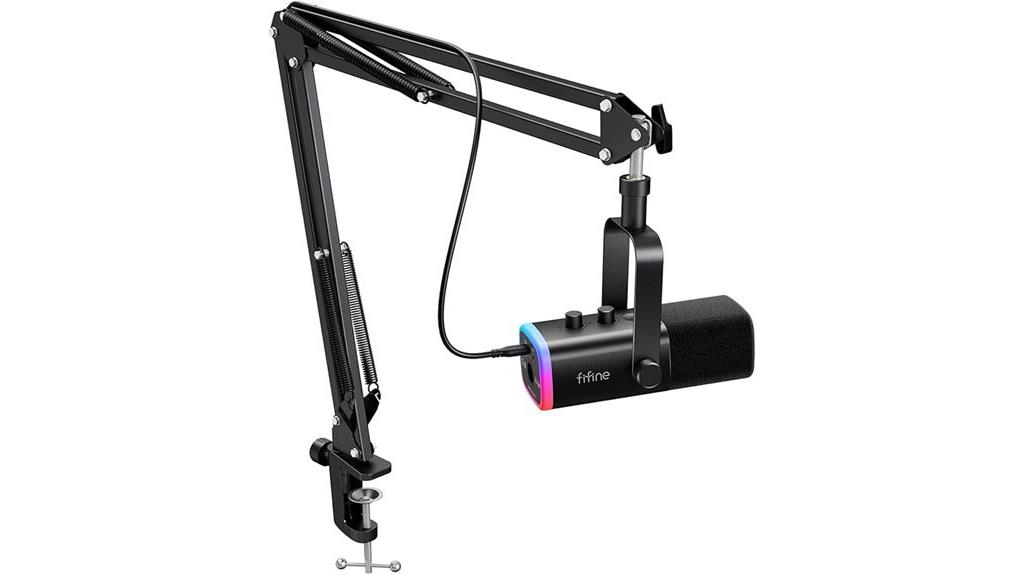
The FIFINE AmpliGame AM8T Dynamic Gaming Microphone Set with Boom Arm emerges as an exceptional choice for gamers and content creators who demand high-quality audio without breaking the bank. Offering both USB and XLR connectivity, the microphone facilitates seamless integration with PCs and sound setups. Key features include a -50dB sensitivity and cardioid polar pattern, designed to reduce background noise and focus on the speaker's voice. The inclusion of a boom arm stand, mute button, gain knob, and headphone jack for real-time monitoring enhances user control and efficiency. Additionally, customizable RGB lighting adds aesthetic appeal to any gaming setup. This microphone set is well-equipped for streaming, podcasting, and voice recording, ensuring broad utility across various audio-centric activities.
Best For: Gamers and content creators looking for a high-quality, versatile microphone with both USB and XLR connectivity at an affordable price.
Pros:
- Dual connectivity options (USB and XLR) cater to a range of audio setups.
- Includes essential accessories like a boom arm stand, mute button, and real-time monitoring capabilities.
- Customizable RGB lighting adds a visually appealing element to gaming or streaming setups.
Cons:
- XLR cable not included, requiring additional purchase for full functionality.
- Some sensitivity to background noise, which may necessitate additional noise filtering measures.
- Limited frequency response range compared to some higher-end microphones.
MAONO Gaming USB Microphone (DGM20S)
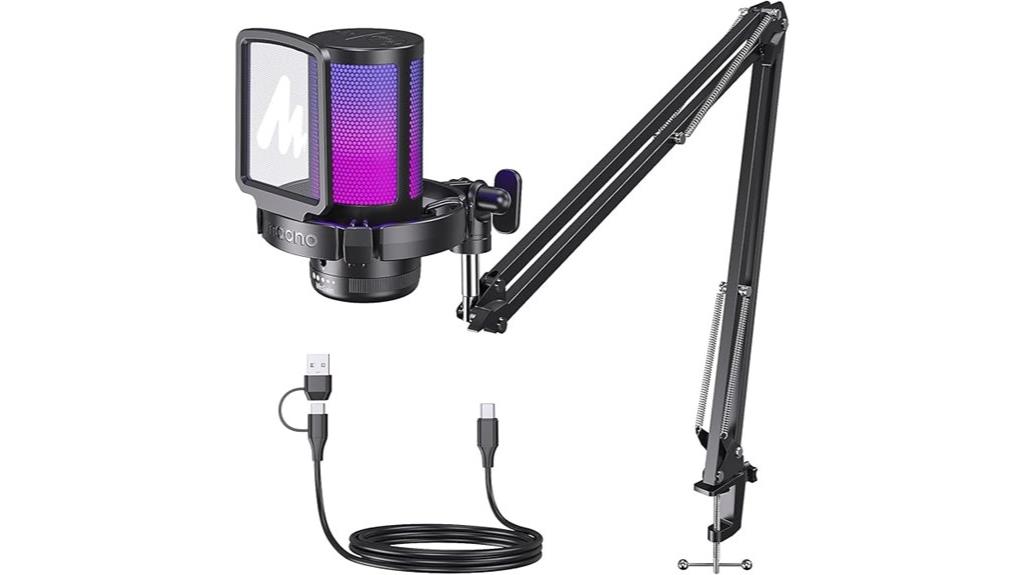
Designed to enhance the audio experience for gamers, podcasters, and streamers, the MAONO Gaming USB Microphone (DGM20S) stands out with its advanced noise cancellation technology and cardioid pickup pattern. It features a sleek design with RGB lighting adjustable through nine different modes, adding aesthetic appeal to its functionality. The microphone includes a one-click mute button and a mic gain knob, allowing easy adjustments during live sessions. The zero-latency monitoring ensures real-time audio feedback without delay, crucial for professional-quality sound production. Compatible across multiple platforms including Windows, Mac, and PlayStation, its plug-and-play setup requires no additional drivers, making it highly accessible for users of all tech levels.
Best For: Gamers, streamers, and podcasters looking for a budget-friendly, high-quality USB microphone with easy setup and aesthetic RGB lighting.
Pros:
- Excellent sound clarity and noise cancellation suitable for professional use.
- RGB lighting with 9 customizable modes enhances visual appeal.
- Easy plug-and-play setup across multiple platforms like Windows, Mac, and PlayStation.
Cons:
- Build quality concerns, particularly with the stability of the arm stand.
- Cord management can be cumbersome, complicating setup.
- Limited frequency range compared to professional microphones.
MAONO USB Microphone (AU-A04)
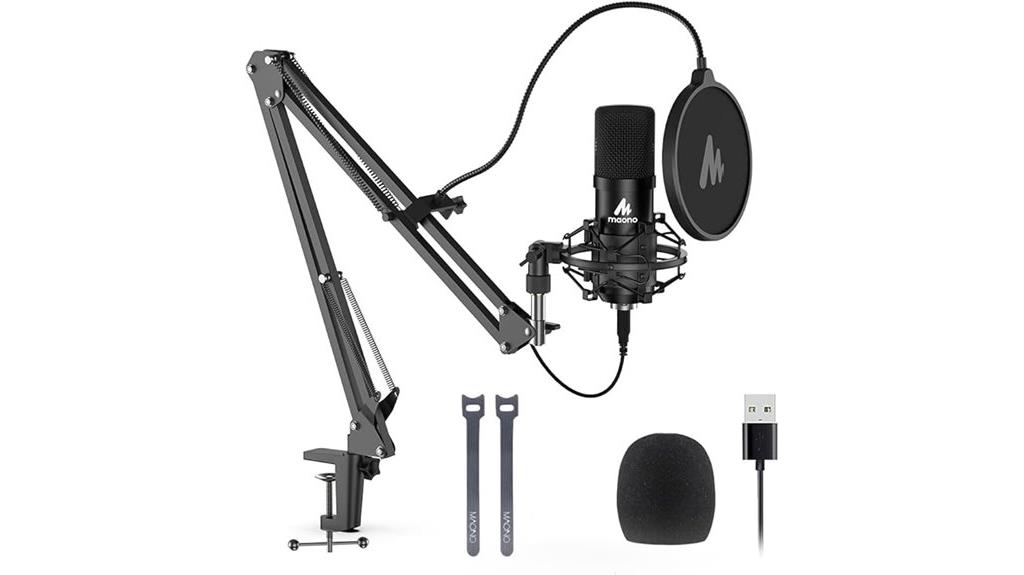
MAONO USB Microphone (Model: AU-A04) stands out as an exceptional choice for budget-conscious creators who demand high-quality audio without breaking the bank. This condenser microphone impresses with a professional sound chipset that ensures high-resolution audio reproduction, boasting a sampling rate of 192kHz/24Bit and a frequency response of 30Hz-16kHz. The 16mm electret condenser transducer offers a strong bass response and crystal-clear audio, making it ideal for podcasts, voiceovers, and gaming. Its plug-and-play USB connectivity with PCs and Linux means no drivers are required, and the included anti-interference magnet ring minimizes cable noise. The comprehensive accessory pack, including an adjustable scissor arm stand and a metal shock mount, enhances user experience by facilitating easy setup and stable microphone positioning. With over 14,608 reviews averaging a 4.4-star rating, users frequently praise its sound quality and sturdy construction, though some note the lack of a mute button and occasional background noise challenges.
Best For: Content creators and beginners looking for a professional-quality, budget-friendly USB microphone for podcasts, gaming, and voiceovers.
Pros:
- High-quality audio with 192kHz/24Bit sampling rate and clear sound reproduction.
- Plug-and-play compatibility with PCs and Linux, enhancing user convenience.
- Includes a comprehensive set of accessories for immediate setup and use.
Cons:
- Lacks a mute button, limiting on-the-fly audio control.
- Installation challenges with the windscreen, potentially affecting ease of setup.
- Some users report issues with background noise, requiring additional noise filtering.
Audio-Technica AT2020 Studio XLR Microphone
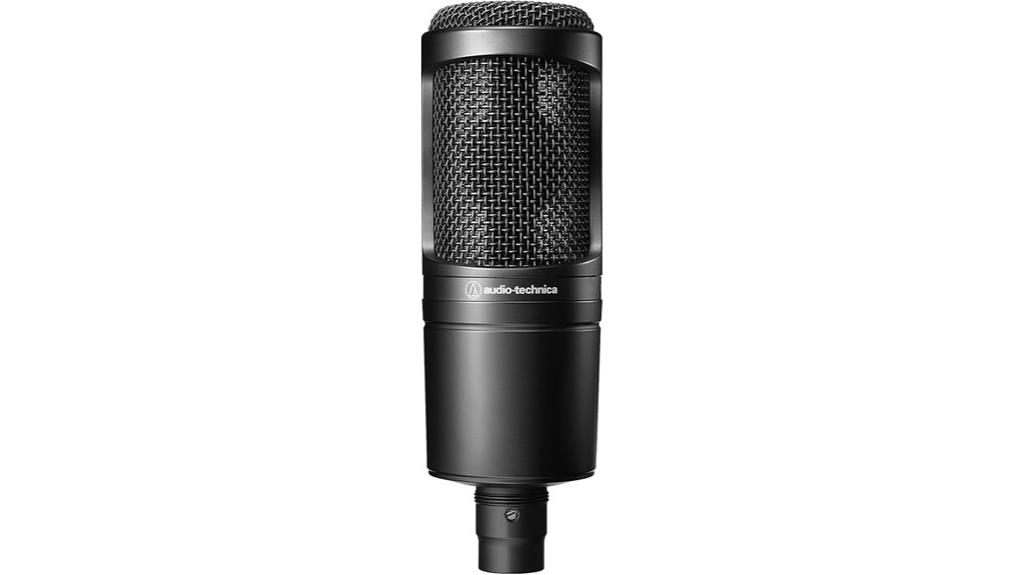
Offering exceptional clarity and a robust build, the Audio-Technica AT2020 Cardioid Condenser Studio XLR Microphone stands out as an excellent choice for both novice and experienced audio creators working within a budget under $100. Designed primarily for project and home studio applications, this microphone features a cardioid polar pattern that effectively minimizes sound pickup from the sides and rear, enhancing the focus on the source in front of it. With a frequency response tailored by a custom-engineered low-mass diaphragm, it delivers extended highs and a dynamic range that tolerates high sound pressure levels, making it versatile for voice acting, streaming, and music recording. Its durable metal construction and sleek design ensure longevity and aesthetic appeal, while its high sensitivity requires careful setup to optimize sound capture.
Best For: Beginners and seasoned audio creators looking for high-quality, budget-friendly studio equipment.
Pros:
- Versatile applications including voice acting, streaming, and music recording.
- Durable metal construction with a sleek, aesthetically pleasing design.
- Cardioid polar pattern effectively minimizes unwanted background noise.
Cons:
- High sensitivity can pick up ambient noise if not carefully set up.
- Requires 48V phantom power, which may not be available in all setups.
- Not ideal for mobile use without proper equipment due to its sensitivity and power requirements.
FIFINE Amplitank K688 Dynamic Microphone for Podcast Recording
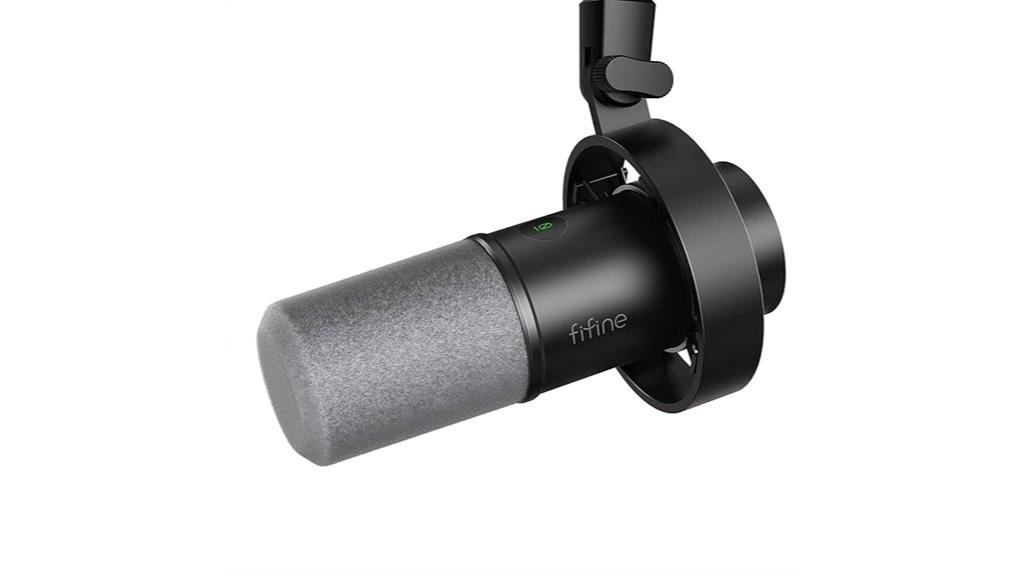
The FIFINE Amplitank K688 Dynamic Microphone stands out in the sub-$100 category, particularly for podcasters seeking a versatile and reliable audio solution. This microphone features dual connectivity with both USB and XLR outputs, enhancing its usability across different devices and setups. Its robust metal construction and professional black finish make it durable and aesthetically pleasing for any recording environment. With a frequency range of 50Hz-16KHz and a signal-to-noise ratio of 80 dB, it delivers clear, detailed vocal recordings with minimal background noise. The inclusion of real-time monitoring through a 3.5mm jack and integrated volume controls further enriches the user experience, making it ideal for both novice and seasoned podcasters.
Best For: Content creators and podcasters looking for a high-quality, versatile microphone with dual connectivity options at an affordable price.
Pros:
- Dual USB and XLR connectivity provides flexibility for various recording setups.
- Solid metal construction and professional design ensure durability and aesthetic appeal.
- Integrated real-time monitoring and volume control enhance recording experience.
Cons:
- Limited frequency response up to 16 kHz may not capture the full spectrum of sounds as compared to other professional mics.
- XLR connection requires additional equipment like a mixer or interface, increasing setup complexity.
- Noise level at 75 dB might be higher than some competitors, potentially affecting recording clarity in very sensitive environments.
Factors to Consider When Choosing Microphones Under $100 in 2025
When selecting microphones priced under $100 in 2025, it is crucial to evaluate several key factors to ensure you get the best value for your investment. Sound quality remains paramount; look for models offering robust noise cancellation and clarity. Additionally, consider the device's connectivity options, build quality, design aesthetics, and compatibility with other equipment to enhance user experience and functionality.
Sound Quality Essentials
In selecting microphones priced under $100 in 2025, several key factors relating to sound quality are paramount. Frequency response is critical, with an ideal range of 50Hz to 16kHz, which is especially effective for capturing the nuances of the human voice, ensuring both clarity and detail in vocal recordings. This range helps to reproduce both the depth of lower tones and the clarity of higher tones accurately.
Sensitivity levels, typically measured in dB, are also crucial. Microphones with sensitivity ratings from 75dB to 80dB are preferred as they are adept at picking up quieter sounds while minimizing background noise, thus ensuring cleaner sound quality. This feature is particularly important in environments with variable noise levels.
Another vital aspect is the polar pattern, with cardioid being a popular choice. Cardioid microphones focus on sounds coming from the front, significantly reducing pickup from the sides and rear. This pattern is beneficial for enhancing vocal clarity by isolating the subject from unwanted ambient sounds.
Additionally, a good signal-to-noise ratio (SNR) of 80dB or higher is desirable. A higher SNR means the microphone can better distinguish the main sound from background noise, resulting in a clearer audio output. Real-time monitoring via a headphone jack is also advantageous, allowing for immediate auditory feedback and adjustments, crucial for achieving professional-quality recordings.
Connectivity Options
Understanding the connectivity options available for microphones under $100 is critical for users who require versatile and efficient recording setups. USB plug-and-play connectivity is a popular choice due to its simplicity, allowing quick and hassle-free connection to computers without the need for additional software or hardware. This feature is particularly beneficial for podcasters, gamers, and home studio enthusiasts who seek ease of use.
On the other hand, XLR connectivity caters to those looking for higher audio quality and more professional setups. XLR microphones require an audio interface or mixer, which can be a worthwhile investment for enhanced sound control and quality. This type of connection is favored by musicians and audio engineers who require reliable performance during recordings.
Furthermore, some budget-friendly microphones now offer dual connectivity, combining USB and XLR outputs. This flexibility allows users to adapt to different recording situations, whether at home or in a studio. Additionally, the inclusion of a headphone jack for real-time audio monitoring is invaluable for achieving precise sound quality during live recordings or streams.
Lastly, ensuring that the microphone's connectivity options are compatible with your devices—whether PCs, consoles, or mobile phones—is essential to prevent any operational hitches.
Build and Design
While connectivity options form the backbone of a microphone's functionality, the build and design are equally important, especially for microphones priced under $100. These microphones often utilize durable materials like metal and ABS plastic, which not only provide a robust frame but also ensure longevity and stability during use. This is crucial for users who regularly reposition their setups or engage in on-the-go recording.
Many budget microphones are equipped with adjustable boom arms or stands, a feature that greatly enhances their versatility. This allows users to easily adjust the microphone to capture sound optimally, a key factor for producing clear and professional audio. Additionally, accessories such as shock mounts and pop filters are frequently included, helping to shield recordings from unwanted vibrations and noise, thereby improving the overall sound quality.
Furthermore, the integration of lightweight and portable designs in this price bracket simplifies the setup process in various recording environments, from home studios to outdoor locations. Also, aesthetic features like RGB lighting are becoming more common, catering to users who value visual appeal in their gaming or streaming setups. These design elements not only improve functionality but also enhance the user experience, making these microphones a popular choice among budget-conscious consumers.
Compatibility Considerations
Choosing the right microphone under $100 involves carefully considering its compatibility with your existing equipment and software. USB connectivity is paramount for those seeking hassle-free plug-and-play functionality, particularly when connecting to PCs or gaming consoles. This feature allows for immediate use without the need for additional drivers, making it an excellent choice for gamers and streamers alike.
Furthermore, it's essential to ensure that the microphone is compatible with your operating system, whether it be Windows, Mac, or Linux. This compatibility helps avoid potential headaches related to driver installations and software conflicts. For those involved in more professional recordings or live sound environments, checking for XLR outputs is crucial. These outputs allow the microphone to connect seamlessly with external mixers or sound interfaces, thus enhancing the overall audio quality.
Additionally, zero-latency monitoring capabilities are a significant advantage, offering real-time audio feedback without delay during recordings. This feature is particularly beneficial for podcasters and musicians who rely on immediate auditory cues. Lastly, confirm that the microphone supports widely-used streaming and recording software like OBS and Zoom, ensuring it integrates smoothly into your existing setup.
Noise Cancellation Features
After considering compatibility, another key aspect when selecting an affordable microphone is its noise cancellation capabilities. Microphones under $100 with effective noise cancellation features are crucial for achieving clear audio, especially in untreated environments. Technologies such as cardioid pickup patterns are particularly valuable. They primarily capture sound from the front, significantly reducing unwanted noise from the sides and rear. This directional approach helps in isolating the subject's voice or instrument, making it a preferred choice for podcasters, musicians, and content creators who operate in non-studio settings.
The effectiveness of these features is often measured by the signal-to-noise ratio. A higher ratio indicates a microphone's superior ability to distinguish desired sounds from background noise. Some models come equipped with built-in noise cancellation technology that actively minimizes ambient sounds during recordings, which can be a game-changer for clarity.
However, potential buyers should also consider the microphone's sensitivity rating. While a higher sensitivity ensures that subtle sounds are captured, it might also pick up more background noise. Consequently, checking if additional noise filtering features are available is advisable to ensure the microphone delivers optimal performance in various settings.
Budget-Friendly Picks
Given the vast array of budget-friendly microphones available in 2025, consumers must carefully consider several factors to ensure they select the best model for their needs without exceeding the $100 limit. Essential features to look for include plug-and-play functionality, adjustable gain controls, and mute buttons to enhance ease of use, particularly for streaming or recording purposes. Additionally, choosing a microphone with a cardioid polar pattern is advisable as it helps reduce background noise and ensures clearer sound quality, making it ideal for gaming and podcasting.
Another critical aspect is the build quality of the microphone and the inclusion of accessories like boom arms, shock mounts, and pop filters. These accessories not only contribute to the durability of the microphone but also significantly improve audio performance across various environments. Moreover, opting for microphones that support both USB and XLR connections can offer greater flexibility, accommodating different setups and future upgrades.
Finally, it is beneficial to consider customer reviews, focusing on high ratings and positive feedback particularly regarding audio clarity and reliability. Such endorsements from users often highlight microphones that provide the best value for money within the budget limit.
Ease of Setup
Ease of setup is a paramount consideration when selecting microphones under $100, especially as technology continues to evolve in 2025. Consumers should prioritize plug-and-play microphones that allow for instant connectivity without the hassle of installing additional drivers. This feature is particularly valuable for users who need quick setup times for activities like podcasting, gaming, or home recording.
Moreover, microphones that come equipped with adjustable boom arm stands and shock mounts provide significant advantages. These additions not only improve the microphone's stability and audio quality by minimizing vibrations but also eliminate the need for separate purchases, making them cost-effective and user-friendly.
USB connectivity is another crucial factor to consider. Microphones with USB ports offer easy integration with a variety of devices, including computers and gaming consoles, facilitating a seamless setup process. Additionally, user-friendly controls such as gain knobs and mute buttons enhance the usability of the microphone by enabling effortless adjustments during live sessions or recordings.
Finally, checking customer reviews can provide insights into the ease of setup and overall reliability of the microphone. Reviews often highlight user experiences with installation and performance, guiding potential buyers towards making well-informed decisions in their microphone selection.
Conclusion
In conclusion, the selection of microphones under $100 in 2025 offers diverse options tailored to various user needs, including gaming, podcasting, and studio recording. Noteworthy features such as dual connectivity, advanced noise cancellation, high-resolution audio, and real-time monitoring enhance user experiences. These microphones not only fulfill the demand for affordability but also do not compromise on quality, making them ideal for consumers seeking cost-effective solutions in their audio recording endeavors.










